Text
Symposium Piece--Sanderling Duo (Sandpipers in the Sun)

Here is the process of me working on the shading and coloration of the second sanderling--unfortunately I forgot to take process photos in the first, and forward, one. These were done in Faber-Castell chalk pastel pencils on gray toned paper.
I first tested a variety of different mediums against a cut piece of gray toned paper to see what was the most vibrant--I picked the gray toned paper to have it stand out against the white plumage of the more forward sanderling. Chalk and the chalk pastel stood out the most, but I wanted to get its coloration done, so I chose chalk pastel in the end.





0 notes
Text
March 1st, 2019--Grassy Waters (Peninsula Ribbon Snake)
Grassy Waters was absolutely gorgeous! I found so many interesting, different kinds of flora and fauna (including an alligator), but I was stumped—I couldn’t decide what it was that I wanted to draw. There were so many options! Kristina and I walked towards the back to see if something would catch our eyes, and I saw something moving off to the side of the platform. I crouched down and saw a little, thin snake slithering over some palm fronds and later, cypress leaves. I quickly took a bunch of photos and resisted the urge to grab it for myself (because it was so cute). The snake is a Peninsula (or Southern) ribbon snake. Its classification is: Kingdom: Animalia; Phylum: Chordata; Class: Reptilia; Order: Squamata; Suborder: Serpentes; Family: Colubridae; Genus: Thamnophis; Species: Thamnophis sauritus sauritus; Subspecies: Thamnophis sauritus sackeni. They range from 16-30 inches long, and live in the southeastern US, but live mostly in Florida. They are found in marshes, ponds, lakes, and along the shores of streams, and have a (generally) green-olive, or a light black coloration. Their dorsal stripe can be olive-gray to greenish-yellow; there are also marguerite yellow stripes along its sides. This one was a really fun find—I drew it along its background, and I’m using another photo of the snake as my second larger project.


0 notes
Text
February 22nd, 2019--Greenway View
On February 22nd, we were told to go and explore the Abacoa Greenway—and I immediately was drawn to going to the bridge, to draw a landscape. Little did I know how much foliage, and how complicated, it would be. From palm fronds to dead branches to bay grape leaves (Cocooloba uvifera), I really tested my hand at different patterns and I tried to represent most of them in the drawing below. Certain low-hanging branches would constantly dip into the water and make ripples, which was very enjoyable and relaxing. I did simplify it a little to get the general gist of most of the different plants around, and I sketched it in graphite (B-4B).


0 notes
Text
February 8th/15th--Coral Cove (Sandpipers, Anastasia Formation, Man o’ War)
On February 8th and 15th we visited Coral Cove beach. It was windy, sunny, and warm, but overall beautiful (around 78 degrees F); I found a lot of interesting things and was immediately taken by the color, and brightness, of the Portuguese man of war (Physalia physalis) that was on the ground. Before this class, I thought that they were jellyfish—they’re actually siphonophores. Instead of being a single multicellular organism, they’re composed of specialized individual animals called zooids or polyps. They are colonial organisms. Their classification is: Kingdom: Animalia; Phylum: Cnidaria; Class: Hydrozoa; Order: Siphonophorae; Suborder: Cystonectae; Family: Phyisaliidae; Genus: Physalia. I got very close to it and even touched its sail, reminded of my first experience with these creatures when I was young (I was three in Hillsboro Beach—I thought it was a water balloon, and its tentacles wrapped around my arm). I did a quick sketch in pencils (B-4B); I do think I had a hard time with making it look translucent because I made it too dark. I followed with a watercolor painting, but I went too heavy again with the coloration, and I did make it a little chunky and thick.
The next week, I decided to try my hand at the Anastasia formation, which is made up of calcite Coquina rock, quartz sands, and sandy limestone. I also saw some fossils among the stone—different shells, mostly. This type of formation runs along the coast of north to central-south Florida. It was a very interesting formation—it housed different, small crabs and different sections of tide pools. I was trying to find some specimens among those areas but had little luck this time.
I’m much stronger at drawing animals than landscapes and objects, I’ll admit—I was trying to get the grooves and the more rounded texture of the rock, but I failed to bring in too much dimension. Plus, the tide was rising fast, and all of the smaller rocks and the side of the formation was soon covered too.
Later, a small flock of sanderlings came and flitted around me—I managed to get a photo from afar. Sanderlings’ classification is: Kingdom: Animalia; Phylum: Chordata; Class: Aves; Order: Charadriiformes; Family: Scolopacidae; Genus: Calidris Species: (Calidris alba). They were absolutely adorable, and I couldn’t stop myself from sketching one. This would later be the inspiration for my Symposium piece.
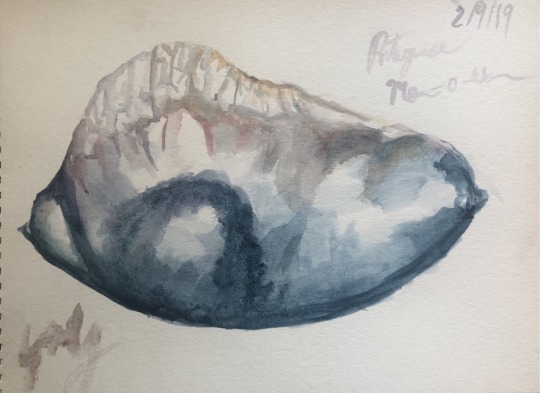
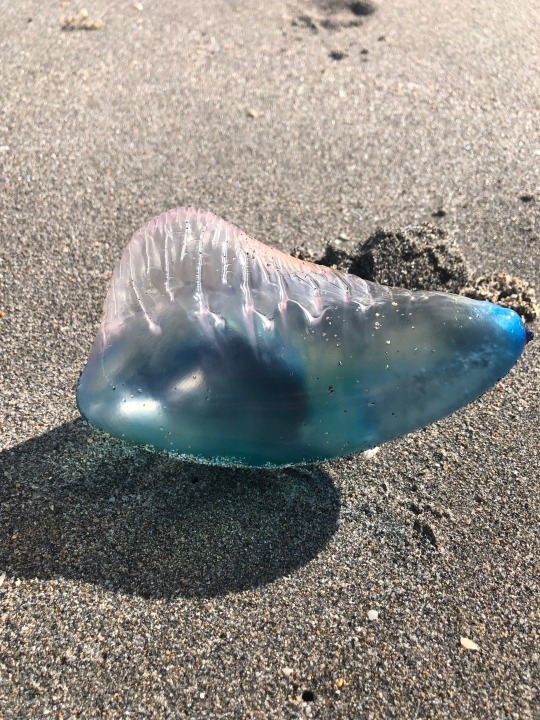
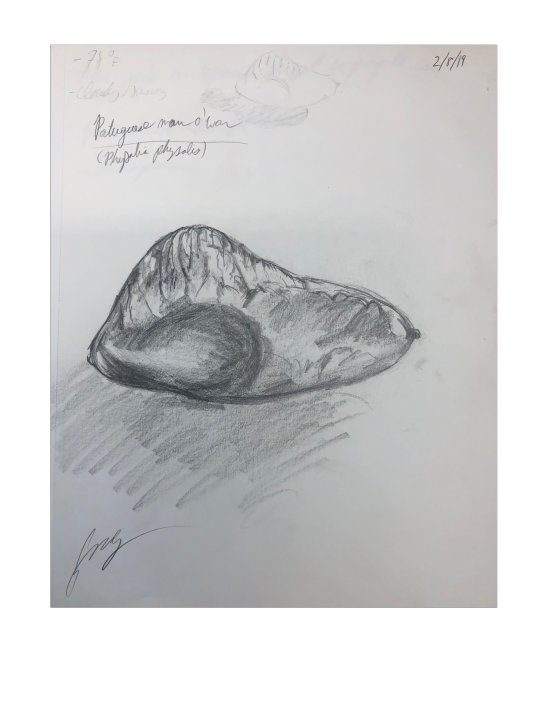

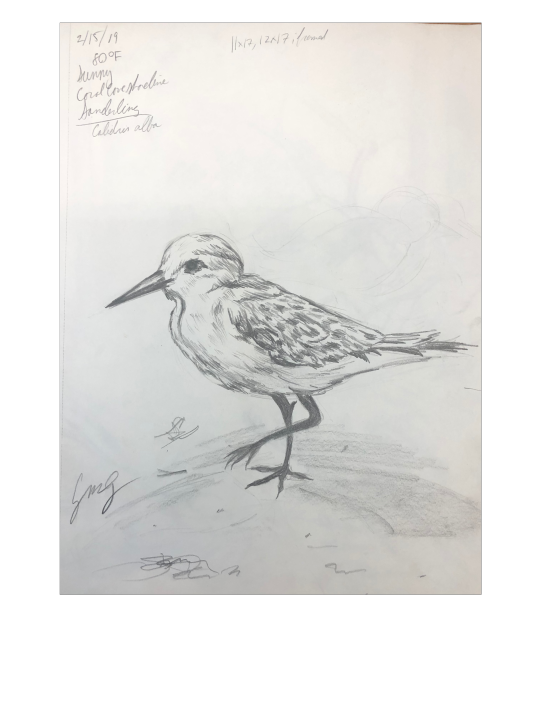
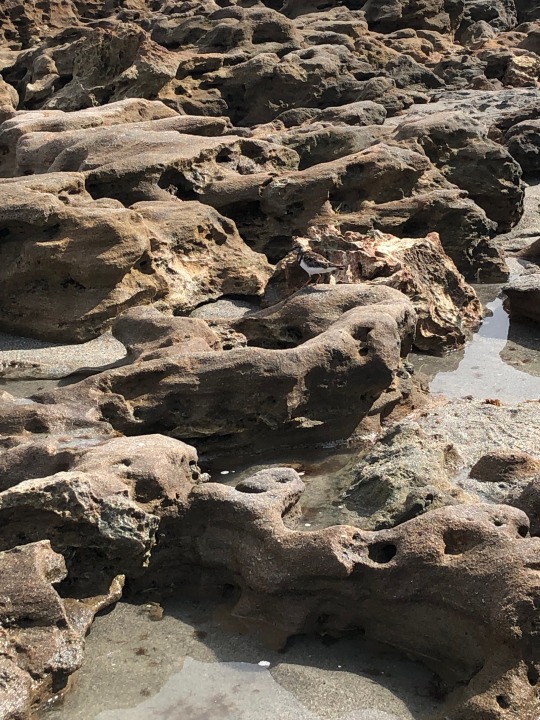
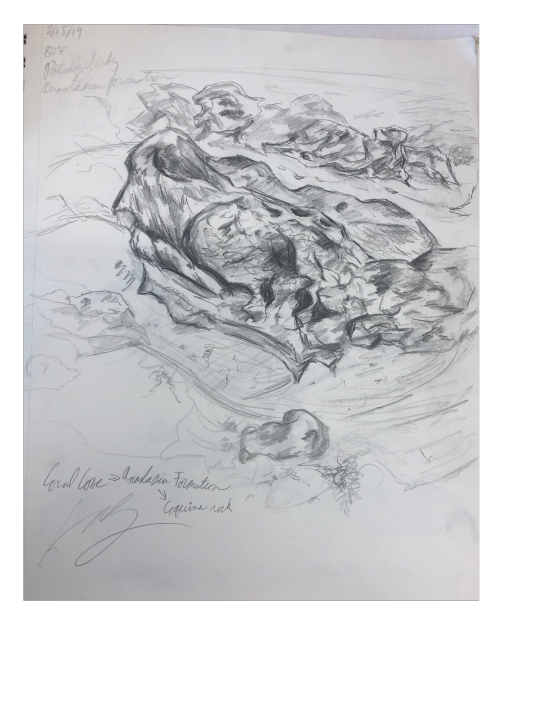
0 notes
Text
February 1st, 2019 (cont.)--Pinecone
This pinecone was arguably, and still is, the most aggravating piece of work I’ve done in this entire class—but with that being said, I’m extremely proud of how it came out. It looks very accurate to the source photo, and though for some reason a little bit of the quality is lost, it was still a very fun piece to create. My biggest issue was with the spokes of it—I lost track when I got towards the middle (since I started on the sides), and so I had to number off each spoke in order to complete it and try to match it. If I were to complete this piece again, I’d make sure to redo the lines in the center of the ‘cross-section’—they aren’t as even and uniform as the reference photo, but it definitely helped me and my use of linework. This was done mostly with a 1mm Prismacolor illustration pen; in some of the areas with darker lines I used a 3mm, and in the finest areas I used a 005mm pen.


0 notes
Text
February 1st, 2019--Lichen on Wood
[Not seen: 20 photos of me trying to take a good photo of what I saw. Shaky hands.]
For my birthday, I had the honor of drawing encrusting lichen on a section of wood. It was actually a lot of fun, but dizzying fun. I was too short to sit well when drawing the piece beneath the microscope, and it took a while for me to get used to the double-vision (literally), so I had to squat as I drew—and it became very uncomfortable. Still, it was very easy to basically ‘trace’ over what I was seeing in real time—I used a pencil first, and then went over it with a Prismacolor 1mm pen to show more contrast. The lichen was extremely textured; I felt like I was drawing some kind of fantasy map instead of drawing a plant! It had different holes, ridges, and cells that all grew together atop the wood—I was trying to differentiate it with the wooden sections (which were cut halfway along the root of the oak branch). It was 4in long and .75in wide.


0 notes
Text
Jan. 25th, 2019--Malachite and Ball Moss
The first sketch, and what took up most of the class, is from a cut piece of malachite (Cu2CO3(OH)2), a copper carbonate hydroxide mineral. It immediately caught my eye and I rushed over to grab it from the options of different ‘curiosities’, that were from objects taken from archaeological digs to minerals. I was caught first by its coloration and its bulbous form; it was a connected set of round pieces, and when cut, it had a ringed pattern that reminded me of tree trunks when cut open. The underside of it was also beautiful, showing more of those rings, as well as having some white ‘cut’ sections from it being moved around and whatnot.
I sketched it out first and went into the coloration, using my set of Prismacolor colored pencils (the pack of 132). However, I couldn’t find any singular color that matched the color of the stone, so I layered and layered to mixed results. The color still isn’t matched, but in certain areas (especially in the bottom section, where the greens were darker) it worked well. I found that most blues were too bright, and the greens were too dark.
There are three layers of colored pencil that went into this: first, cloud blue, jade green, light aqua, and spring green; I went over it with parrot green (which was the closest match to the stone, but it was still too blue), aquamarine, and peacock blue (which was way too blue for this). The darker parts were made with grass green and dark green. It was the first time I used colored pencils in a long time (~2 years), so it was strangely unfamiliar territory, but it inspired me to re-use them.
I added a slight speckling pattern to signify the stuck-on sand and texture around the top globules, and I left it less shaded/blended-in in areas where there was sand so that the piece had that rough texture. Prismacolor pencils seem like oil pastels in the way that they blend—I really enjoy using them, but it’s a lot of work with layering.
The ball moss (Tillandsia recurvata) was also fun to draw because of its long, winding leaves. Its classification is: Kingdom: Plantae Order: Poales Family: Bromeliaceae Genus: Tillandsia. I didn’t realize that they were a kind of moss—I’d seen them around and figure that they were a type of parasite, but ball moss isn’t a harmful parasite like misletoes can be—it generally has a small effect on the trees it can grow on. It photosynthesizes its own food and gets nitrogen through the bacteria it is surrounded by. They’re actually several ‘pups’ formed into one ball rather than being one complete unit, which also surprised me. Though the one I had was six inches long and 3 inches wide, and was .08 grams, they can range greatly—from golf balls to soccer balls.
I did this sketch mostly in pencil, and added a smidge of color with colored pencil afterwards. I used hatching to get the texture and show the direction of the leaves.



0 notes
Text
Week 2: Audubon (Arboretum)
On the 18th the class had traveled to the Arboretum behind the campus, and we were tasked with exploring and finding interesting subjects. I was hoping for some insect or animal, so I initially chased a zebra butterfly down--but it wouldn’t stay still. I ended up in the back of the Arboretum, next to a dry field and behind the HC building. The temperature was warm and mild--mid-low 70′s, but sunny. There was light wind as well. It was a gorgeous day to be outside, but a lot of bugs flew around--I got attacked by a few while drawing.
With the butterfly gone, I decided to check and see what plants were interesting nearby. The beauty berry’s purple berries caught my attention, so I went beneath it and started drawing--first from afar, to get the vague shape of the drooping branch, and then closer-up to get some details in. The entire section bent and blew in the wind, and was extremely malleable. The leaves ruffled, but no insects were on them. Maybe a caterpillar ate the edge of the plant, because some leaves looked like they’d been chewed on and partially bitten, but when I did research on the beauty berry, the fruit can be used as an insect repellant. I wonder if the same chemical that repels insects in the berries runs through the leaves as well...
Callicarpa americana (commonly known as the beauty berry) is a shrub that is native to the United States--there are other varieties of Callicarpa, but they are endemic to other regions of the world. They are pretty large shrubs, running from 3-6 feet tall (the one that I came across was ~4 feet high), and can be just as wide. The one that I was drawing seemed about 4 feet wide as well. It was very durable and flexible, bending in the wind, and had large, flat, either ovate or elliptic leaves that seemed mostly symmetrical. I found it fascinating that some were much wider than other, though; while some leaves were long and thin, others were short and wide. The leaves were smooth and thick, not paper-thin, but also are durable. I didn’t try a berry, but I have heard that they have a very astringent flavor.
As a little kid, my mom used to tell me that those berries were poisonous--I never knew the name of them, or understood why they were everywhere, but they are beautiful berries that are, to my surprise, non-toxic. Deer and birds eat them, but the seeds are not digested and are eventually released back into the earth: that is how beauty berries spread. They like moist soil, but don’t require a lot of water. Partial shade is necessary, however (which made sense--the one I came across was beneath the shade of taller trees). They are tolerant to cold and heat, and they are gorgeous plants.
Due to their frequent use in landscaping due to their gorgeous purple berries, and their easy growth, they are not endangered or threatened.
After I drew the two sketches--one with more shading with a 2B and 4B pencil, very quick sketches--I decided to move onward and find something else to draw. I came across a stump, and I used that as my next subject. It was clearly hacked down and seemed to be dead--it was gnarled and a dark brown, with reddish-yellow undertones. It was an entire cluster around dry leaves, and I did a small sketch from afar (in the bottom right) and a closer one in the center of the page. When I asked Dr. Moore about what it was, he said there were no hints--so I just left it as ‘unknown’. I did a little bit of color off to the side, using violet blue to shadow and contrast against the yellow and red undertones I’d set and layered with brown. It was also in a tucked-away corner in the very back edge of the Arboretum, beneath a large tree.


3 notes
·
View notes
Text
Week 1, Post 2: Audubon (Class Summary)
In class, I was enlightened on many things that I didn’t know, but definitely am glad that I know now. As simple as it is, we were handed a worksheet with a set of materials. I’ve taken a lot of art classes before, but using a feather as a way to brush away any dust or eraser particles is genius. I’m definitely going to invest in getting one.
I also now understand why old maps had fantastical-looking beasts! They are probably artist renditions of sailors’ tales of whales and such, and krakens are exaggerations of sailors telling of mysterious, giant squids. Looking at Ulisse Androvandi and Albrecht Drüer’s work was enlightening--even going back to Arthur Lakes’s dinosaur dig photo showed how art was useful in many aspects for furthering scientific research, as well as acting as a catalogue.
Scientific drawing is all about accuracy, and I believe that’ll be a personal struggle. I tend to exaggerate features, as well as colors (especially colors) so to tone them back and to be as accurate to the specimens I’m drawing will be a challenge I’m ready to take. I’m excited to learn about nature and to unify both art and science, two personal passions of mine.
And I’ll definitely make sure to sign my work!
0 notes
Text
Week 1, Post 1: Audubon--FL Maple
We were instructed to look around the school campus and find an object to draw. I, of course, picked the largest object that would be practical to draw: a dried, slightly torn, leaf.
What I found was a Florida Maple (or Southern Sugar Maple) leaf (Acer saccharum var. floridum, formerly known as Acer barbatum). They are a variation on a maple family, not an entirely separate species, and are commonly found in the lower half of the United States, even though they are not native to North America. They are attractive trees, commonly placed in urban design, due to being showy, pest-resistant, and simple to grow. They give a lot of shade, ranging from 50 to 60 feet tall and 25 to 40 feet wide. Because they are so common and often used for public spaces, they are not in any threat of extinction; there are no protections on the species in general.
Their leaves are star-shaped and symmetrical; the one I grabbed was dried, so it was cracked on the left side and punctured with a few holes. It had warm red undertones and a few yellow spots, but darkened the closer it got to the edges. It had some freckling, as well as thick veins that gave the leaf a lot of texture. It was an interesting plant, and a beautiful one. I see these leaves everywhere in Florida, and finally, I got the chance to look at one.
Though it was dried, the leaf itself was still supple, which I found interesting. I could bend it, but after a certain point it started to crack. The underside had an interesting, lighter brown coloration; the veins were more defined on the back as well.


0 notes